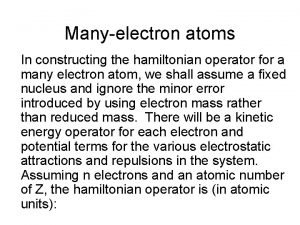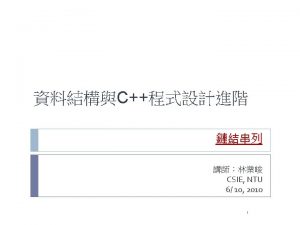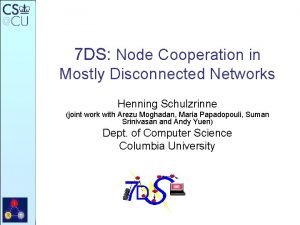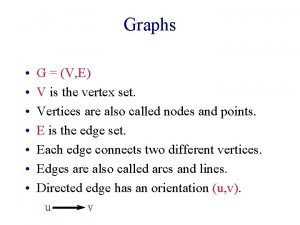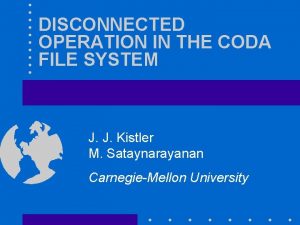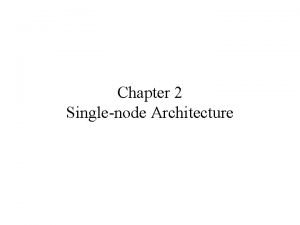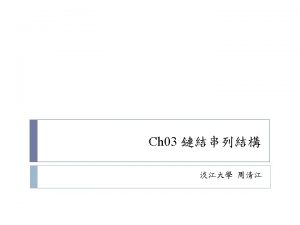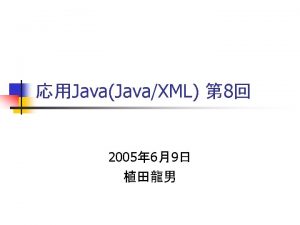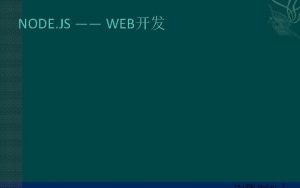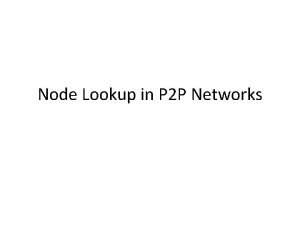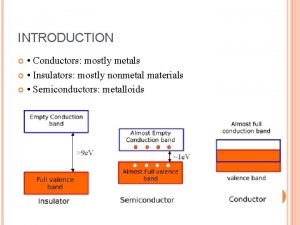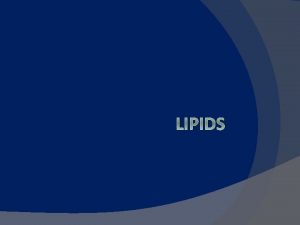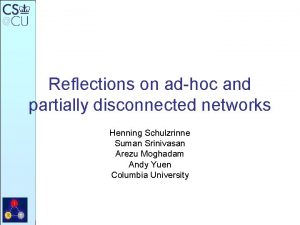7 DS Node Cooperation in Mostly Disconnected Networks
















- Slides: 16

7 DS: Node Cooperation in Mostly Disconnected Networks Henning Schulzrinne (joint work with Arezu Moghadan, Maria Papadopouli, Suman Srinivasan and Andy Yuen) Dept. of Computer Science Columbia University

Problems with Wide Area Wireless • • 802. 11 currently hard to deploy across city or large area 2. 5 G/3 G wireless networks not suitable for large data volumes – cost and network design Problem: How can mobile devices / gadgets get and generate information? Examples: – PDAs and smartphones • digital content such as news, maps, tourist information, entertainment – digital still and video cameras MB of data Solution: 7 DS!

Concept • Use local peer-to-peer wireless networks to exchange information – Peers can get information they do not have from another peer • Model core Internet data applications – Internet mobile: web access (retrieval) – Mobile Internet: email (messaging) • Once wireless 7 DS network set up, it could be used for any purpose – Getting web pages from peers – Sending e-mails – File transfer to selected client

Illustration In the absence of the Internet, nodes can exchange information amongst themselves Internet

Realization

System architecture web browser proxy search engine Internet email client email queue

Design • Peer-to-peer network set up using zeroconf – Protocol enables devices to get IP address and communicate without a DHCP / other server • Proxy server serves content – If connected to Internet, functions normally – If not connected, connects to peers to get information

Design • Search engine – Allows self / peers to search within the device’s database for necessary information • Multicast querying system – Allows peers to query systems in peer-to -peer network – Searches can be for files or keywords • Transport System – To forward e-mail

Design

Connection & Proxy Server • Connection set up using zeroconf protocol – Similar to Apple. Talk, Microsoft NETBIOS, Novell IPX – Uses link-local addressing, multicast DNS, DNS service discovery • Proxy server – Peer’s user client uses localhost proxy server by default – Detects Internet connection availability – If Internet, normal network operation – No Internet, peer-to-peer data exchange

Search Engine • Provides ability to query self for results • Searches the cache index using Swish-e library • Presents results in any of three formats: HTML, XML and plain text • Similar in concept to Google Desktop

Query multicast engine • Used to actually exchange information among peers • Requesting peer broadcasts a query to the network • Responding peers reply if they have information – Send encoded string with list of matching items • Requesting peer retrieves suitable information

Analytical work on 7 DS • Email upload application – How to remove message replicas upon email delivery? – Impact of a feedback channel? • P 2 P file exchange – Throughput related to content popularity model – How to improve dissemination for unpopular content? • Push based vs. Pull based data dissemination – Bloom filter based vs. query based strategy – Optimal design parameters for Bloom filter based algorithm

Email Delivery App • How to remove redundant message replicas upon email delivery? – Time-based (TB): purge message upon TTL expiration TB(TTL) – Hop-based (HB): purge message when dissemination tree reaches specific depth and breadth HB(breadth, depth) – Feedback (FB): receive notification upon message delivery • 4 Schemes: TB, HB, TB/FB, HB/FB • Storage cost (number of message replicas) Arrival to AP 17 min on avg TB(170) HB(2, 6) HB(3, 4) HB(4, 3) HB(7, 2) No Feedback 3169 114 102 75 50 Feedback(FB) 54 41 32 29 18

Email Delivery App (Cont ‘d) • Hop-based scheme is superior, with smaller expected cost and variance • Expedited (100 sec) and reliable message delivery (Pd=1) possible at small cost – 50 replicas for HB(7, 2) • With feedback HB(7, 2) has a cost of 18 replicas Stopping time: time when all message replicas are purged Message delivery time: time when email message is delivered FB and NFB schemes have same message delivery time statistically Stopping time and message delivery time is the same for FB schemes

Conclusion • 7 DS promises to allow local connectivity • Exchange of information within local network • No user intervention unless absolutely necessary • New step in practical, large-scale wireless networking with gadgets? – Remains to be seen
 Parallel spin
Parallel spin Reference node and non reference node
Reference node and non reference node Struct node int data struct node* next
Struct node int data struct node* next Interference and standing waves
Interference and standing waves Typedef struct in c
Typedef struct in c Reference node and non reference node
Reference node and non reference node Group of carbon
Group of carbon Outlook disconnected
Outlook disconnected Disconnected epidural catheter guideline
Disconnected epidural catheter guideline Is the dog barked a complete sentence
Is the dog barked a complete sentence 7ds network disconnected
7ds network disconnected Gvev
Gvev What is coda file system
What is coda file system Simple disconnected graph with 3 vertices
Simple disconnected graph with 3 vertices Single node architecture in wireless sensor networks
Single node architecture in wireless sensor networks Virtual circuit and datagram
Virtual circuit and datagram Basestore iptv
Basestore iptv
